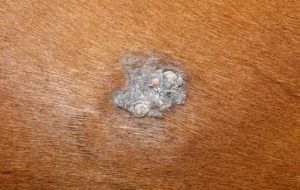
Sarcoids are common skin tumors found in horses, believed to stem from a viral origin. These growths, although benign, can be a cause for concern due to their persistence and potential complications. In this article, we will delve into the origins of this condition, how to recognize it, risks for both horses and humans, available treatments, monitoring progress, and possible treatments for complications.
-
-
-
- Origin and causes: Sarcoids are believed to be caused by bovine papillomavirus (BPV) infection, although other factors may also contribute. BPV enters the horse’s skin, likely through cuts, insect bites, or other minor skin injuries, triggering the development of sarcoids.
- Identification:
Sarcoids can manifest in various forms, including flat, thickened, ulcerated, or nodular lesions. They often appear in areas with little hair, such as the abdomen, groin, axilla, eyelids, and face. Differentiating sarcoids from other skin conditions is crucial for accurate diagnosis and treatment.
- Risks for humans and horses: Sarcoids are not zoonotic and do not pose a direct threat to human health. However, they can be problematic for horses, potentially causing discomfort, cosmetic issues, and interference with tack or harness placement.
- Treatment approaches:
a. Topical Treatments: Creams or ointments containing various chemicals can be applied directly to the sarcoid. Common options include imiquimod, 5-fluorouracil, or cisplatin.
b. Cryotherapy: Freezing the sarcoid with liquid nitrogen helps destroy the abnormal tissue.
c. Surgical Excision: Complete removal of the sarcoid, although recurrence is possible.
d. Radiotherapy: Controlled radiation is used to treat sarcoids and has a good success rate.
e. Electrochemotherapy: Combining chemotherapy drugs with electroporation for enhanced treatment effectiveness. - Monitoring progress: After treatment, regular follow-ups with a veterinarian are essential to monitor the progress of the treated sarcoid and detect any recurrence or complications.
- Handling complications:
In case of complications, such as infection or excessive inflammation after treatment, appropriate antibiotics and anti-inflammatory medications will be administered.
-
-
Sarcoids can be challenging to manage, and individual cases may respond differently to treatments. It’s crucial to consult a veterinarian to tailor the treatment plan to your horse’s specific needs. Early intervention and a well-managed treatment plan can help improve outcomes and enhance the overall well-being of your horse.

